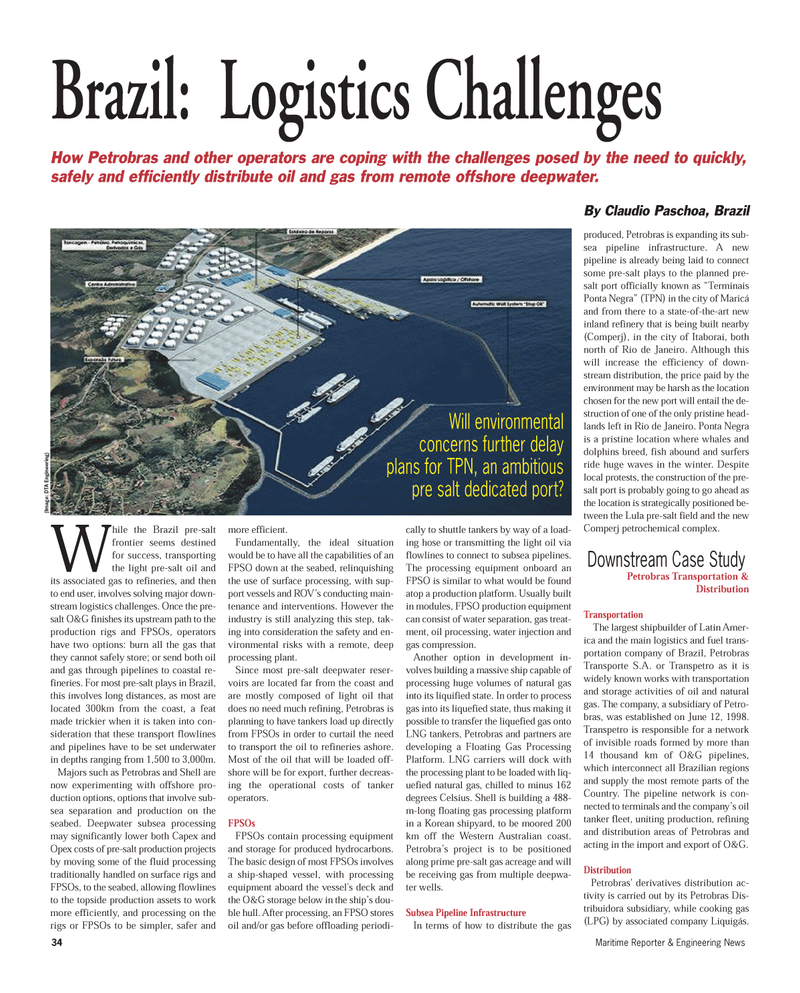
Page 34: of Maritime Reporter Magazine (July 2012)
Arctic Operations
Read this page in Pdf, Flash or Html5 edition of July 2012 Maritime Reporter Magazine
34Maritime Reporter & Engineering News While the Brazil pre-saltfrontier seems destinedfor success, transportingthe light pre-salt oil andits associated gas to refineries, and then to end user, involves solving major down- stream logistics challenges. Once the pre-salt O&G finishes its upstream path to the production rigs and FPSOs, operatorshave two options: burn all the gas that they cannot safely store; or send both oil and gas through pipelines to coastal re- fineries. For most pre-salt plays in Brazil, this involves long distances, as most are located 300km from the coast, a featmade trickier when it is taken into con- sideration that these transport flowlines and pipelines have to be set underwater in depths ranging from 1,500 to 3,000m. Majors such as Petrobras and Shell arenow experimenting with offshore pro- duction options, options that involve sub- sea separation and production on theseabed. Deepwater subsea processing may significantly lower both Capex and Opex costs of pre-salt production projects by moving some of the fluid processing traditionally handled on surface rigs and FPSOs, to the seabed, allowing flowlines to the topside production assets to work more efficiently, and processing on the rigs or FPSOs to be simpler, safer and more efficient. Fundamentally, the ideal situation would be to have all the capabilities of an FPSO down at the seabed, relinquishing the use of surface processing, with sup- port vessels and ROV?s conducting main- tenance and interventions. However the industry is still analyzing this step, tak-ing into consideration the safety and en-vironmental risks with a remote, deepprocessing plant.Since most pre-salt deepwater reser- voirs are located far from the coast and are mostly composed of light oil thatdoes no need much refining, Petrobras is planning to have tankers load up directly from FPSOs in order to curtail the needto transport the oil to refineries ashore. Most of the oil that will be loaded off- shore will be for export, further decreas- ing the operational costs of tanker operators. FPSOsFPSOs contain processing equipmentand storage for produced hydrocarbons. The basic design of most FPSOs involves a ship-shaped vessel, with processing equipment aboard the vessel's deck and the O&G storage below in the ship?s dou- ble hull. After processing, an FPSO stores oil and/or gas before offloading periodi- cally to shuttle tankers by way of a load- ing hose or transmitting the light oil viaflowlines to connect to subsea pipelines. The processing equipment onboard anFPSO is similar to what would be found atop a production platform. Usually built in modules, FPSO production equipmentcan consist of water separation, gas treat- ment, oil processing, water injection and gas compression. Another option in development in- volves building a massive ship capable of processing huge volumes of natural gas into its liquified state. In order to process gas into its liquefied state, thus making it possible to transfer the liquefied gas onto LNG tankers, Petrobras and partners are developing a Floating Gas Processing Platform. LNG carriers will dock withthe processing plant to be loaded with liq-uefied natural gas, chilled to minus 162 degrees Celsius. Shell is building a 488- m-long floating gas processing platform in a Korean shipyard, to be moored 200 km off the Western Australian coast. Petrobra?s project is to be positioned along prime pre-salt gas acreage and will be receiving gas from multiple deepwa- ter wells.Subsea Pipeline Infrastructure In terms of how to distribute the gas produced, Petrobras is expanding its sub- sea pipeline infrastructure. A new pipeline is already being laid to connectsome pre-salt plays to the planned pre-salt port officially known as ?Terminais Ponta Negra? (TPN) in the city of Maricá and from there to a state-of-the-art new inland refinery that is being built nearby (Comperj), in the city of Itaborai, bothnorth of Rio de Janeiro. Although this will increase the efficiency of down- stream distribution, the price paid by the environment may be harsh as the location chosen for the new port will entail the de- struction of one of the only pristine head-lands left in Rio de Janeiro. Ponta Negra is a pristine location where whales anddolphins breed, fish abound and surfers ride huge waves in the winter. Despite local protests, the construction of the pre-salt port is probably going to go ahead asthe location is strategically positioned be- tween the Lula pre-salt field and the new Comperj petrochemical complex. Downstream Case Study Petrobras Transportation & Distribution Transportation The largest shipbuilder of Latin Amer- ica and the main logistics and fuel trans-portation company of Brazil, Petrobras Transporte S.A. or Transpetro as it is widely known works with transportation and storage activities of oil and natural gas. The company, a subsidiary of Petro- bras, was established on June 12, 1998. Transpetro is responsible for a network of invisible roads formed by more than 14 thousand km of O&G pipelines,which interconnect all Brazilian regions and supply the most remote parts of theCountry. The pipeline network is con- nected to terminals and the company?s oil tanker fleet, uniting production, refining and distribution areas of Petrobras and acting in the import and export of O&G. Distribution Petrobras' derivatives distribution ac- tivity is carried out by its Petrobras Dis- tribuidora subsidiary, while cooking gas (LPG) by associated company Liquigás. Brazil: Logistics Challenges How Petrobras and other operators are coping with the challenges posed by the need to quickly, safely and efficiently distribute oil and gas from remote offshore deepwater. By Claudio Paschoa, BrazilWill environmental concerns further delay plans for TPN, an ambitiouspre salt dedicated port? (Image: DTA Engineering) MR#7 (34-41):MR Template 7/9/2012 9:55 AM Page 34

 33
33

 35
35
